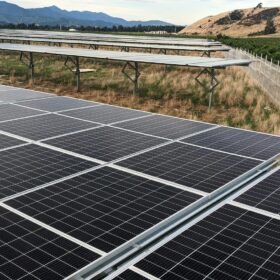Mauritius seeking consultants for four solar-plus-storage projects
The state-owned Central Electricity Board of Mauritius has opened a tender for consultants to assist with the implementation of four 10 MW solar plus storage facilities.
EU set to dig into raw materials supply
The European Union has drawn up new regulations to boost the domestic mining of raw materials and support production of renewable energy products and materials at home. Will it be enough to incentivize investment, or will Europe trail other major economies, such as the United States and China?
Study estimates global floating solar potential at 1,302 TWh
A UK-based research team has calculated the global potential of deploying floating solar arrays on almost 68,000 lakes and reservoirs. It found some countries could generate the majority of their electricity needs from floating solar panels, while five could meet all their electricity demand.
Release by Scatec to expand solar, storage capacity in Cameroon
Release by Scatec, a distributed-generation solar and battery energy storage systems (BESS) solution, is set to expand its solar and storage capacity in Cameroon by 28.6 MW and 19.2 MWh across two solar plants.
Amea Power secures financing for 120 MW of solar in South Africa
Amea Power says it has obtained financing for a 120 MW solar plant near Klerksdorp, South Africa. The funds include $100 million in debt from Standard Bank South Africa and $8 million in equity from Industrial Development Corp.
Funding round opens for off-grid solar across West Africa
The Economic Community of West African States (ECOWAS) is offering grants from $10,000 to $250,000 in the second funding round of the Regional Off-Grid Electricity Access Project (ROGEAP) to develop off-grid solar in 13 West African and sub-Saharan African countries. The application deadline is June 23.
Amea Power switches on 26.6 MW solar farm in Burkina Faso
Amea Power has connected the Zina solar plant to the grid in Burkina Faso, to power the Mana gold mine in Mouhoun province.
Angola inaugurates 25.3 MW solar park
The Angolan authorities have inaugurated a 25.3 MW solar park built by Portugal’s MCA and Sun Africa. The project is the fourth of seven installations that are being built for the Angolan government, with a combined capacity of 370 MW.
Mali to build 200 MW of solar with Russian support
The authorities in Mali have revealed plans to build a 200 MW solar plant with backing from Russia.
Novel attempt to design solar cell based on chalcogenide perovskite delivers 13.86% efficiency
Scientists in South Africa have proposed a new chalcogenide perovskite solar cell design based on a compound known as barium zirconium sulfide. They tested different hole transport materials in the new device and found that a polymer known as P3HT achieved the best performance.










